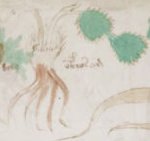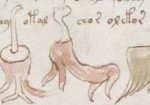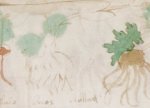So why this bother to find out about the animal shapes of the roots in the manuscript? Well, the idea is to find the plant’s name that the author used. Plants are known by many names in many languages, so an identification like “it’s a viola” doesn’t directly lead to clues to decipher the manuscript. Instead, it’s more useful to try to find the name that the author used to refer to the plant. That’s where the animal clues could be very important. If the author took the trouble to draw a plant with roots in the shape of an animal, it’s very likely he thought of the plant as ‘animal root’. Checking the known names for the plant could possible lead to the written name of the plant.
In the recipe section of the Voynich manuscript there are some pictures that could be labelled with the name of the plant as the author used it.
I selected this one because of the hairy tufts at the top of the root, and the shape of the leaves.
The label reads (EVA): opchosam
This root has a definite animal shape and also shows some hairs at the top of the root.
The label reads (EVA): chor.olekor
The image is a bit vague. But still two animal shapes can be made out in the root. There is a trace of flakes at the top of the root. However, the representation of the rest of the plant isn’t like f34v. This seems to be the least likely candidate.
The label can be read as (EVA): sheol though I prefer to read it as (EVA): oschol



